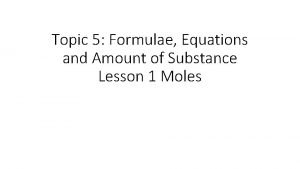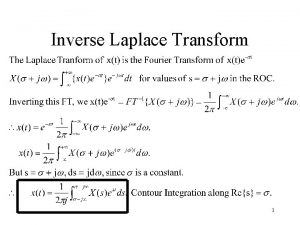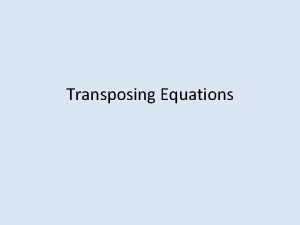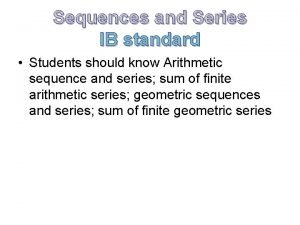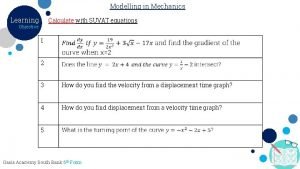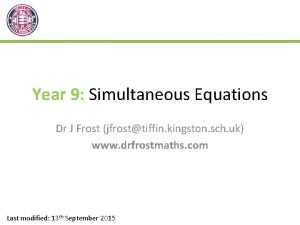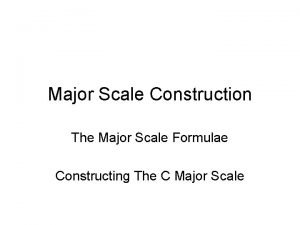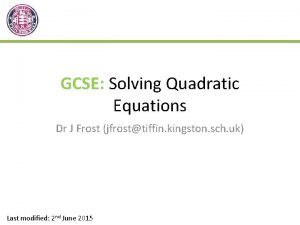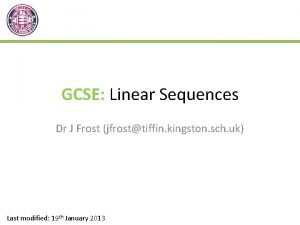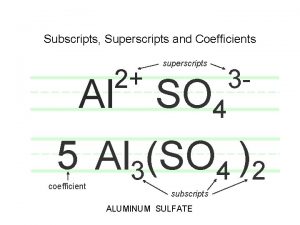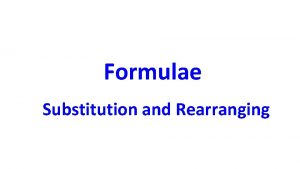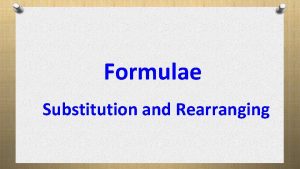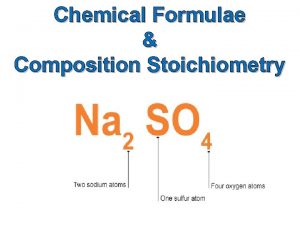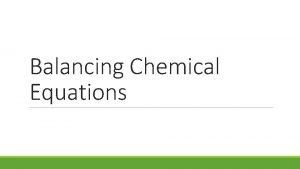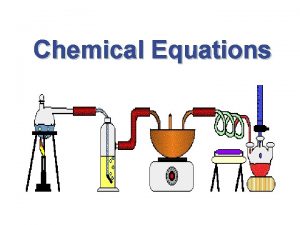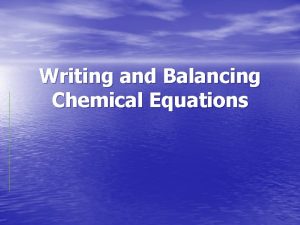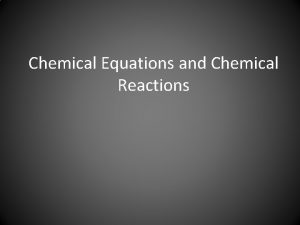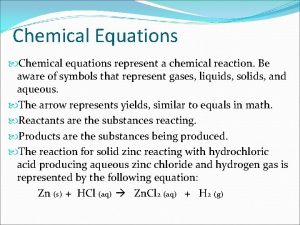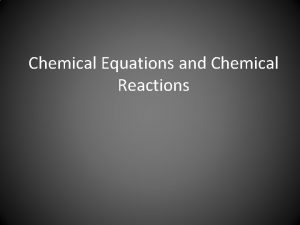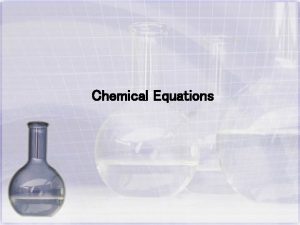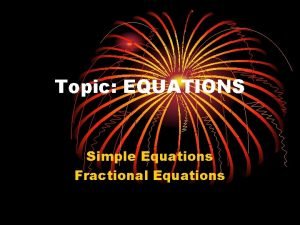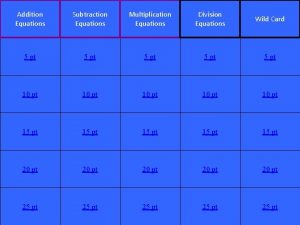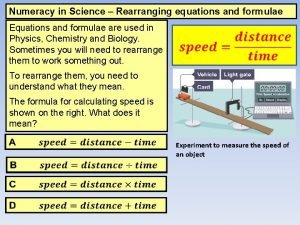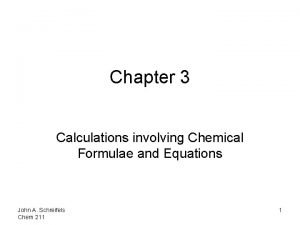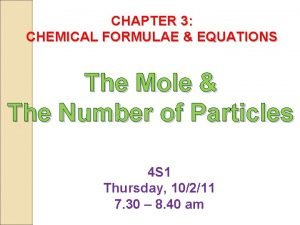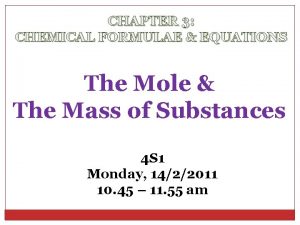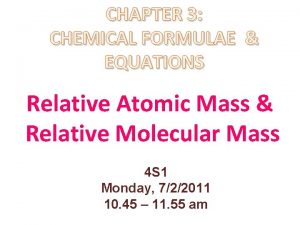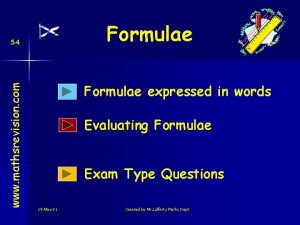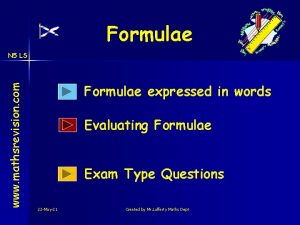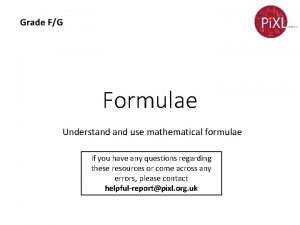CHAPTER 3 CHEMICAL FORMULAE EQUATIONS Chemical Formulae 4























- Slides: 23

CHAPTER 3: CHEMICAL FORMULAE & EQUATIONS Chemical Formulae 4 S 1 Tuesday, 1/3/11 10. 45 – 11. 55 am

Instead of writing long description of chemicals or substances, chemists write their chemical formulae. For example, hydrogen gas is written

So, what is a chemical formula? ? ?

Chemical formula = a representation of a chemical substance using letters for atoms & subscript numbers to show the numbers of each type of atoms that are present in the substance

The letter ‘N’ shows the symbol of nitrogen atom N 2 The subscript ‘ 2’ shows that there are 2 nitrogen atoms in a molecule of nitrogen gas

The letter show the symbols of the element Li 2 O There is no subscript here. This means that there is only 1 atom of oxygen in this molecule The subscript ‘ 2’ shows that there are 2 lithium atoms in a molecule of lithium oxide, Li 2 O

Chemical formula Empirical Molecular formula

Empirical formula = the simplest whole number ratio of atoms of each element in the compound e. g. : formula of glucose C 6 H 12 O 6 E. F of glucose = = CH 2 O

Determining empirical formula of a compound

Refer page 42 of Textbook Element Ca F Mass of element, m (g) No. of moles, n (mol) 0. 20 0. 39 – 0. 20 = 0. 19 19 = 0. 01 0. 005 =2 Ratio of moles 0. 20 40 = 0. 005 =1 E. F. = Ca. F 2

Refer page 42 of Textbook Element % Na 32. 4 S 22. 6 O 45. 0 Mass, m (g) 32. 4 22. 6 45. 0 No. of moles, n (mol) 32. 4 23 = 1. 409 0. 706 =2 22. 6 32 = 0. 706 =1 45. 0 16 = 2. 813 0. 706 =4 Ratio of moles E. F. = Na 2 SO 4

Try Q 3 of Work This Out 3. 7 Calculation page 42

Refer page 42 of Textbook Element Al Mass of element, m (g) 60 – 38. 4 = 21. 6 No. of moles, n (mol) 21. 6 27 = 0. 8 Ratio of moles 0. 8 =1 Simplest ratio of moles 2 E. F. = Al 2 S 3 S 38. 4 32 = 1. 2 0. 8 = 1. 5 3

Chemical formula Empirical Molecular formula

If empirical formula is the simplest whole number ratio, what is molecular formula? ? ?

Molecular formula = the actual number of atoms of each element that is present in a molecule

Molecular formula = (Empirical formula)n Compound Empirical formula Molecular formula n Water H 2 O (H 2 O)1 = H 2 O 1 Ethene CH 2 (CH 2)2 = C 2 H 4 2 Glucose CH 2 O (CH 2 O)6 = C 6 H 12 O 6 6

Determining molecular formula of a compound Tips: must know RMM & E. F. of the cpd to know its M. F.

Refer page 43 of Textbook E. F. = CH 2, RMM = 42. M. F. ? [RAM: H=1, C=12] Assume M. F. = (CH 2)n Based on the M. F. , RMM = n [12 + 2(1)] = 14 n However, RMM = 42 14 n = 42 = 3 14 M. F. = (CH 2)3 = C 3 H 6

Refer page 44 of Textbook E. F. = C 2 H 5, RMM = 58. M. F. ? [RAM: H=1, C=12] Assume M. F. = (C 2 H 5)n Based on the M. F. , RMM = n [2(12) + 5(1)] = 29 n However, RMM = 58 29 n = 58 = 2 29 M. F. = (C 2 H 5)2 = C 4 H 10

Try Q 2 of Work This Out 3. 8 Calculation page 44

Refer page 44 of Textbook E. F. = CH 2 O, RMM = 60. M. F. ? [RAM: H=1, C=12] Assume M. F. = (CH 2 O)n Based on the M. F. , RMM = n [12 + 2(1) + 16] = 30 n However, RMM = 60 30 n = 60 = 2 30 M. F. = (CH 2 O)2 = C 2 H 4 O 2

REMINDER!!! Memorise the ionic formulae of cations and anions for the next lesson
 La quantité de matière
La quantité de matière Are kc and kp equal
Are kc and kp equal Translate word equations to chemical equations
Translate word equations to chemical equations Moles in chemistry formula
Moles in chemistry formula Inverse laplace formulae
Inverse laplace formulae Transposition of equations
Transposition of equations Calculus series
Calculus series Suvat equations units
Suvat equations units Dr frost equations
Dr frost equations Constructing formulae
Constructing formulae Dr frost solving equations
Dr frost solving equations Dr frost sequences
Dr frost sequences What is high art and low art
What is high art and low art What is simple interest
What is simple interest Suvat formulae
Suvat formulae Roi formulae
Roi formulae Chemistry chapter 8 review chemical equations and reactions
Chemistry chapter 8 review chemical equations and reactions Chapter 8 section 1 chemical equations and reactions
Chapter 8 section 1 chemical equations and reactions Chemical equations and reactions chapter 8
Chemical equations and reactions chapter 8 Synthesis reaction
Synthesis reaction Empirical formula and molecular formula pogil
Empirical formula and molecular formula pogil Chemical formulas and chemical compounds chapter 7 review
Chemical formulas and chemical compounds chapter 7 review Polar and rectangular forms of equations
Polar and rectangular forms of equations Subscript formula
Subscript formula
